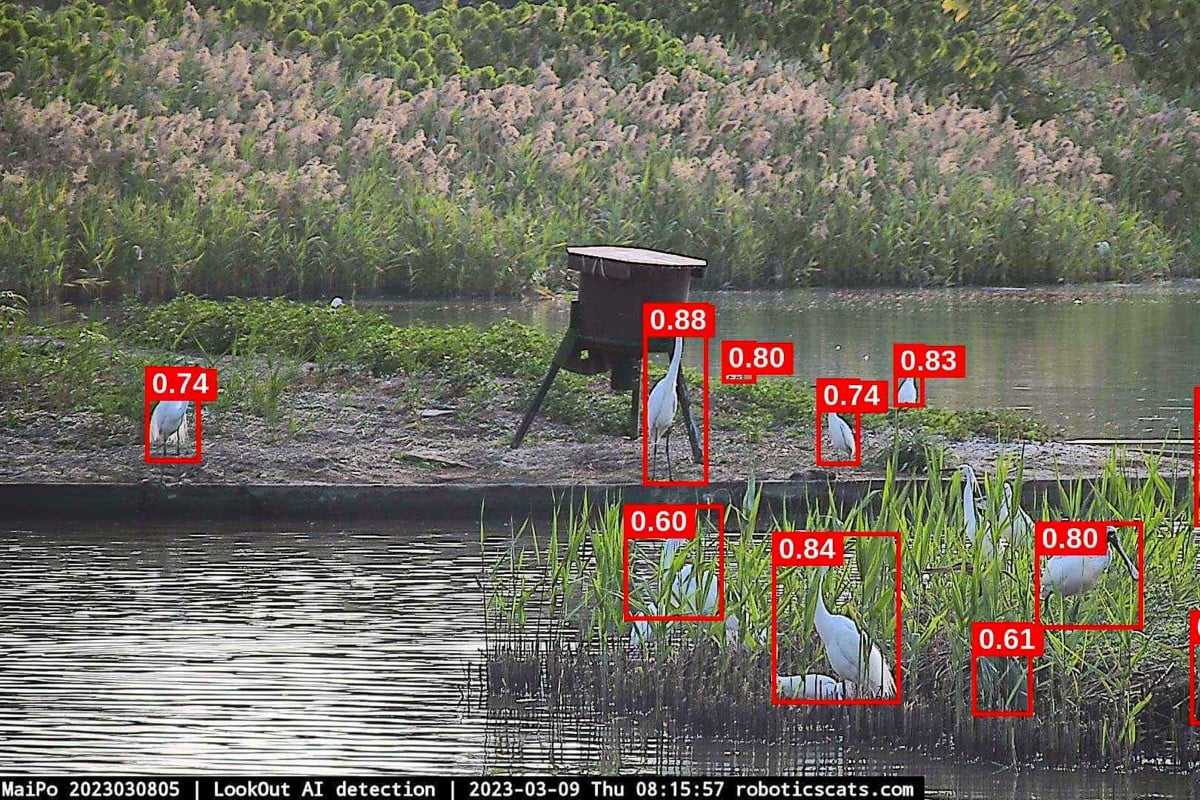
Study Buddy (Challenger): How AI can be used to detect wildfires and monitor endangered birds
- Hong Kong experts, start-up say the technology could give better population estimates and track habits of certain species
- This page is for students who want to take their understanding to the next level with difficult vocabulary and questions to test their inference skills
 An AI-powered bird counting system in action in Hong Kong. Photo: Robotics Cats
An AI-powered bird counting system in action in Hong Kong. Photo: Robotics Cats
[1] The rising use of artificial intelligence (AI) is revolutionising Hong Kong’s conservation efforts. Experts and a start-up have said that the technology offers more accurate population estimates of some species and monitors their habitats more efficiently. Among the recent efforts is Robotics Cats, an AI start-up. The company has just been recognised as a “top innovator” by the World Economic Forum’s platform UpLink.
[2] Andre Cheung Wai-kin, the start-up founder, said his team approached the sector in Hong Kong to explore joint partnerships. The aim is to power conservation and habitat management with AI. With a system involving advanced surveillance cameras, users can detect wildfires and birds and conduct real-time habitat monitoring. It uses an automated wildfire detection tool to identify early-stage wildfires through computer vision and deep learning, drawing from a myriad of more than 500,000 wildfire images.
[3] Similarly, the other AI bird detection system employs thousands of photos to identify species and conduct automated counting. The company has partnered with a local conservation group since September 2023 to test it out. They are working on a 12-month pilot project to conduct AI-powered biodiversity management in wetland habitats in the New Territories. The habitat was remotely monitored during the record black rainstorm warning last September. “This experience allowed us to assess the system’s effectiveness in certain scenarios,” Cheung said.
[4] The company previously partnered with global conservation body WWF-Hong Kong in a project at the Mai Po nature reserve aviary paradise. On January 24, 2023, the system detected a wildfire at Kai Kung Leng in Lam Tsuen Country Park. WWF-HK wetlands research manager Carmen Or Ka-man said, “AI can identify species accurately, perform automated surveillance and process large data sets. With this, we could allocate manpower for data review and interpretation.”
[5] Wang Yu-hsing, associate head of the Hong Kong University of Science and Technology’s civil and environmental engineering department, said: “Since some organisations face manpower shortages, the AI systems can assist in labour-intensive tasks.” Wang added that the system could also operate around the clock, maximising its efficiency.
[6] Other local initiatives are also harnessing AI for conservation and environmental protection. In May, the Agriculture, Fisheries and Conservation Department (AFCD) announced plans to increase the number of AI-assisted hill fire detectors in country parks. According to the department, about 233 hill fires were recorded inside or near country park areas between 2013 and 2023, endangering flora and fauna.
[7] But the technology has limitations. The remoteness of certain habitats may hinder stable power supply and telecoms networks. Challenging environments can also affect AI animal detection, according to Andre Cheung. “Accuracy suffers when the animals are not in full view. It can lead to misdetections and miscounts, affecting data collection,” he said.
Source: South China Morning Post, August 18
Questions
1. How is AI helping conservation efforts according to paragraph 1?______________________________________________________________________________________________________
2. Based on paragraph 1, what is the general trend in Hong Kong conservation efforts?______________________________________________________________________________________________________
3. In paragraph 2, what technology is being used to detect wildfires?
A. deep learning and computer vision
B. 4D surveillance cameras
C. predictive habitat monitoring
D. all of the above
4. What does the “inclement weather” mentioned in paragraph 3 refer to specifically?
__________________________________________________
5. Find a word in paragraph 3 that means “from a distance and without being physically present”.
______________________________
6. Based on your understanding of paragraphs 4 and 5, how can human researchers benefit from the AI system?______________________________________________________________________________________________________
7. Paragraph 6 describes the …
A. risk of Hong Kong’s flora and fauna becoming endangered.
B. impact of hill fires on wildlife.
C. role of the AFCD in environmental protection.
D. application of AI in preventing hill fires.
8. What is one potential solution to the challenges mentioned in paragraph 7?______________________________________________________________________________________________________
9. What is the overall tone towards the use of AI in conservation efforts?
A. ambivalent
B. pragmatic
C. optimistic
D. critical
Answers
1. It provides more accurate population estimates of species and monitors habitats more efficiently.
2. There is a growing reliance on artificial intelligence.
3. A
4. the record black rainstorm warning in September 2023
5. remotely
6. It helps reduce their workload by automating time-consuming and labour-intensive tasks, and they can focus on other work such as data review and interpretation. (accept all similar answers)
7. D
8. enhance infrastructure such as power supply and telecoms networks in remote areas
9. C
